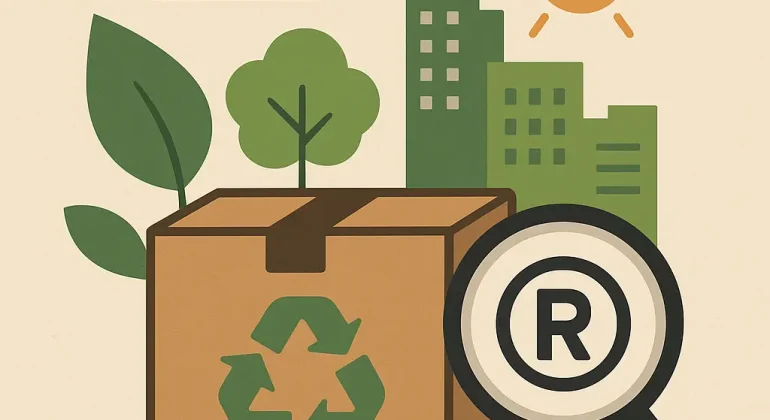The European Union has introduced Regulation (EU) 2025/40 concerning packaging and packaging waste. Although still in the process of being implemented, this regulation will have profound implications for intellectual property right (IP) owners, particularly those with trademarks and designs. While the regulation primarily addresses environmental goals, such as waste reduction and sustainability, it also introduces significant changes that IP right owners must understand to protect their interests and adapt to the evolving legal landscape.
Adopted on December 19, 2024, Regulation (EU) 2025/40 will come into full effect on August 12, 2026. It replaces Directive 94/62/EC and aligns with the EU Green Deal, aiming to reduce packaging waste and promote sustainable alternatives. The regulation mandates specific requirements for the design, production, and disposal of packaging products, urging manufacturers and importers to create packaging with sustainability in mind.
The regulation aims to minimize unnecessary packaging and encourage the use of reusable, recyclable, and eco-friendly alternatives. While these measures are environmentally driven, they directly affect IP right owners whose products are represented through packaging, particularly when it comes to trademarks and designs.
Sommaire
Implications for trademark owners
Packaging protected by trademarks or designs
Trademark owners must be aware of an important exemption in the regulation, which applies to packaging that features elements protected by a registered trademark or design. Packaging that incorporates distinctive features protected by trademark or design law will not be subject to the volume reduction requirements if modifying the packaging would compromise the trademark’s distinctiveness.
For instance, if a packaging design includes a specific shape or visual element that is registered as a trademark (such as a unique container shape), the regulation will not enforce volume reduction or changes that could diminish the trademark’s identity. This exemption is crucial for brand owners wishing to protect their rights, as it allows them to continue using their iconic designs without disruption. Importantly, this exemption applies only to packaging that is protected before February 11, 2025.
Compliance of new packaging
For new packaging designs incorporating a trademark or design registered after February 11, 2025, the packaging must comply with the regulation’s volume reduction requirements. Specifically, new packaging designs cannot include unnecessary components such as double walls, excessive cushioning, or extraneous layers that increase the packaging’s volume artificially. While the exemption safeguards existing trademarks and designs, new registrations will need to balance aesthetic appeal with environmental compliance.
Consequences of non-compliance
Failure to comply with the new packaging rules could lead to significant penalties, though the specific fines have yet to be defined. The regulation grants EU member states the authority to set sanctions, which must be in place by February 12, 2027. Therefore, businesses must stay vigilant and monitor the evolution of national laws to avoid potential enforcement actions.
Implications for design owners
Protection of design features
For owners of design rights, the regulation recognizes that environmental changes should not compromise the design’s distinctive characteristics. Similar to trademarks, designs registered before February 11, 2025, are exempt from certain volume reduction measures. This exemption is crucial for companies that have invested in unique and recognizable packaging designs that play a key role in their branding and market presence.
New designs and compliance
For designs registered after February 2025, the regulation will impose stricter rules concerning the reduction of unnecessary packaging components. Design owners must integrate sustainable practices into their packaging designs without compromising the design’s distinctiveness. This presents an opportunity for innovation, where design owners can create packaging that aligns with both environmental objectives and market trends.
Exceptions for geographical indications
The regulation includes a notable exception for packaging containing products with geographical indications (GIs), such as wine, cheese, and other regional products. These products are exempt from the packaging reduction requirements, regardless of when the GI was granted. This ensures that the distinctive packaging used for GI-protected products remains unaffected by the regulation’s volume reduction rules.
Conclusion: the path forward for IP right owners
As the new packaging regulations come into effect, trademark and design owners must reassess their packaging strategies. Sustainability is becoming an integral part of the business landscape, and it is vital for IP right owners to align their IP protection practices with the environmental obligations set forth in the regulation. To ensure compliance, businesses should start auditing their existing packaging designs to ensure they meet sustainability criteria while maintaining the distinctiveness of their trademarks and designs.
By staying informed about these regulatory changes, IP right owners can safeguard their intellectual property and remain competitive in an increasingly eco-conscious market. With the regulation fully implemented by 2026, proactive steps now will help avoid legal pitfalls and maintain a strong brand presence.
Dreyfus Law Firm works with clients in the food sector, providing specialist advice on intellectual property and regulatory issues to ensure compliance with national and European laws.
We collaborate with a global network of intellectual property attorneys.
Join us on social media !
FAQ
1. What is Regulation (EU) 2025/40 on packaging and waste?
This regulation sets forth rules to reduce packaging waste, encourage recycling, and minimize unnecessary packaging across the EU.
2. How does this regulation affect trademark owners?
Trademark owners may be exempt from certain packaging volume reduction requirements if their packaging is protected by a registered trademark, as long as the changes do not affect the trademark’s distinctiveness.
3. Do all designs have to comply with the new packaging requirements?
Designs registered before February 2025 are exempt from volume reduction rules, but new designs must comply with these requirements.

